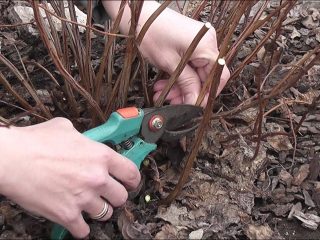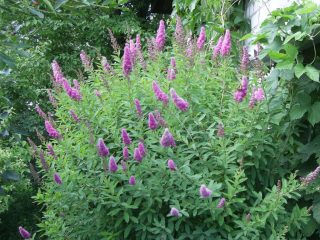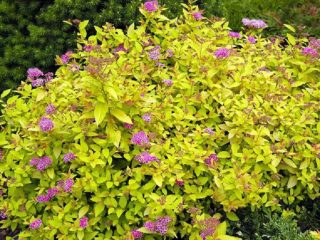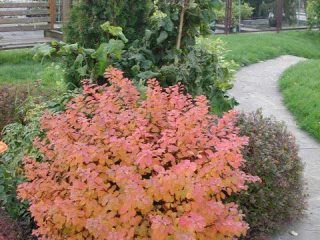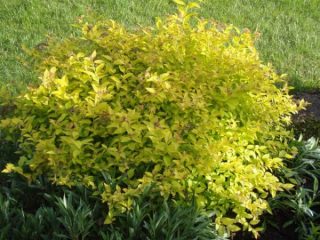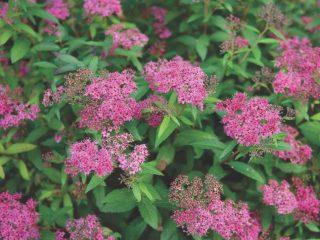Content
Spiraea is a small ornamental shrub that is often used in the country, to decorate personal plots, parks and squares. Landscape designers love it for its beautiful appearance, low maintenance requirements and disease resistance. Indeed, planting and caring for spirea is not difficult; even a novice gardener can easily cope with these tasks.
An overview of the most popular types of spirea shrubs, photos, planting, basic measures for caring for them - further in the article.
How fast does spirea grow?
The growth rate of shoots depends on the type, age of the bush, climate and soil fertility, regularity of watering and fertilizing. Dwarf species can grow by 10-12 cm per season, large bushes grow by 0.7-1 m per year, and sometimes more.
How tall is spirea
The genus Spiraea has about 100 species. Among them there are both compact dwarf shrubs that do not grow higher than 15-30 cm, and tall species that reach a height of 2.5 m by the 4th year of life.
The height of an adult bush of the most commonly grown spirea species is shown in the table below.
Type of spirea | Height of an adult bush, m |
Summer-flowering species | |
Spiraea gray | up to 2 |
Arguta (Sharp-toothed) | 1,5-2 |
Wangutta | up to 2 |
Gorodchataya | up to 1 |
oak leaf | up to 2 |
Nippon | 1,5 |
Average | 1-2 |
Thunberg | 1,5-2 |
Spring-flowering species | |
Spiraea japonica | up to 1.5 |
White | up to 1.6 |
Birch-leaved | up to 0.6 |
Billard | up to 2 |
Boumalda | 0,7-0,8 |
Douglas | up to 1.5 |
Willow | up to 2 |
When to plant spirea in open ground
Spiraea can be planted in open ground in early spring or autumn. It should be borne in mind that spring planting is allowed only for summer-flowering species. In this case, a prerequisite is that the seedling is in a dormant state; there should be no signs of the beginning of the growing season on the bush. In autumn, planting of both spring-flowering and summer-flowering species is allowed. This procedure is done in September.
How to plant spirea
The procedure for planting spirea is not particularly difficult. If you choose the right place and follow the care recommendations, the bush will grow well for 20-40 years.
Where is the best place to plant spirea?
This plant loves the sun very much. Even in the southern regions, you need to choose an open, well-lit place for planting it.If the bush is in the shade of buildings or other trees for a long time during the day, then you should not expect beautiful flowering from it. Only light partial shade is allowed.
The plant does not have any special requirements for the type and composition of soil. Light, fertile soils with good breathability are best suited for planting it. Clay areas can be improved by adding peat and sand. When planting, you should avoid wetlands and places where rain or melt water accumulates.
Preparation of planting material
This shrub can be propagated independently by seeds or vegetative methods:
- cuttings;
- layering;
- dividing the bush.
Ready-made planting material can also be purchased in special stores or nurseries. Spiraea seedlings are usually sold with clay applied to the roots. We need to look at them carefully. The root system should be sufficiently developed, have several tap roots and a lobe. Spring seedlings should not have swollen buds, autumn seedlings should not have leaves. It will be an additional advantage if the seedling is sold in a special container.
Soil preparation
To plant seedlings, you need to dig planting holes in advance. Their depth is approximately 0.7 m; their width is usually made 1/3 larger than the size of the roots of the seedling. The pits are prepared in advance, several days before the planned date of work. If the soil is not entirely suitable, the size of the hole needs to be increased.
A drainage layer of broken bricks or stones about 20 cm thick is placed at the bottom of the pit. A mound of nutrient soil is poured into the center of the pit. The holes are left in this form until planting.
How to plant spirea correctly
Before planting, seedlings need to be inspected. If the roots are dry, it is better to keep them in water for a while. A lobe that is too long can be trimmed. The seedling is placed vertically on an earthen mound poured in the center of the planting hole, and the roots are spread along its slopes. After planting, the root collar should be flush with the surface of the earth, so the height of the mound of earth in the hole needs to be adjusted.
The hole is filled with nutritious soil and lightly compacted to prevent the formation of voids in the roots. After this, the planted bush is watered abundantly, and the root zone is mulched with peat or humus.
Distance between spirea bushes
These plants are planted both individually and in groups. If the bush is planted as a hedge, the distance between neighboring bushes is 0.3 m. In other cases, low-growing bushes are planted at intervals of 0.7-0.8 m, tall ones - at least 1 m.
Spirea transplant
Not all shrubs can tolerate transplanting to another place, since this is quite stressful for the plant. However, spirea is not one of them.
Is it possible to replant spirea?
This ornamental shrub can be replanted at any age. This can be done either as a separate operation or by combining this event with one of the vegetative propagation methods - dividing the bush.
When to replant spirea
Adult bushes are replanted in the fall. The best time to do this is when the leaves begin to change color before leaf fall. To carry out the transplant, choose a cloudy rainy day.
Transplantation of adult spirea
Before transplanting spirea, it is necessary to carry out sanitary pruning of the bush, cutting out all dry branches, as well as cutting off all skeletal shoots to the bud. If the bush is replanted as a whole, it is dug out along with a lump of earth on the roots, transferred to a new place, planted in a planting hole, and then watered abundantly.
How to care for spirea
Quite often, gardeners are skeptical about the need to care for this shrub. This is partly justified, since it is unpretentious and does not require special care. Spiraea is a plant that, if the location is chosen correctly, will bloom after planting and without any care. However, some measures will make the flowering more lush and abundant, as well as prolong the youth and increase the lifespan of this beautiful perennial shrub.
Conditions for growing spirea
The main measures for caring for this plant are the following:
- watering;
- mulching the soil;
- feeding;
- weeding and loosening;
- pruning;
- pre-winter preparation.
How to water spirea
As a rule, there is sufficient precipitation for this shrub. An exception can be made only for young plants, as well as in dry summers. To maintain normal soil moisture, the root zone of each adult bush is watered with 1-2 buckets of water. For low-growing forms, the watering rate can be halved.
What and how to feed spirea
Spiraea, planted on fertile, loose soil, does not need systematic feeding. If the soil is depleted, the bushes can be fed. This is done several times a season according to approximately the following scheme:
- Early spring. Fertilizing with complex nitrogen-containing fertilizer (urea, nitroammofoska) to stimulate the growth of shoots and green mass.You can use organic matter, such as manure or humus.
- Beginning of summer (June). Fertilizing with complex potassium and phosphorus fertilizers (potassium sulfate, superphosphate) to stimulate abundant flowering.
- End of summer (end of August). Fertilizing with potassium and phosphorus fertilizers to prepare for winter.
When to trim spirea
The shrub tolerates pruning well, so it is quite difficult to harm it with this procedure. Trimming the spirea increases the splendor of the bush, gives it a well-groomed appearance, and increases its decorativeness. At the same time, the likelihood of developing diseases is significantly reduced, since the bush begins to let in more light and air.
You can trim spirea throughout the season. In the spring, you need to remove dry and winter-damaged branches. In summer, shrubs older than 3-4 years are pruned in accordance with the selected crown type and maintained in this condition. Stimulating pruning is carried out depending on the type of plant, in late spring or autumn.
How to form a spirea
You can start shaping the bush when it reaches the age of 3-4 years. By this time, the plant will have a sufficient number of shoots, a developed root system and will easily tolerate pruning. Summer-flowering spirea form in early spring, spring blooming - at the beginning of autumn.
Usually the bush is given a symmetrical geometric shape.
How to care for spirea after flowering
Caring for spirea after flowering is very simple. It is better to cut off the seed pods that form in place of the flowers if they are not intended to be collected.This measure often stimulates the plant to bloom again. After the spirea has faded, it continues to be trimmed to maintain the selected shape. In late autumn, the bushes are prepared for winter. The plant has good winter hardiness, so the stems are usually simply tied into a bunch, bent to the ground and covered with a layer of fallen leaves.
Spiraea flowering
Depending on the type of plant, flowering occurs in different parts of the shoot. Flowers can cover all branches, their upper part, or only their tips. Flowers are usually collected in inflorescences, which can be of the following forms:
- shield;
- paniculata;
- spicate;
- pyramidal.
The color range of inflorescences is very wide. Flowers can be snow-white, cream, crimson, pink.
When does spirea bloom?
According to the type of flowering, all types of this shrub are divided into spring-flowering and summer-flowering. They differ in that in the first, flowering occurs on the shoots of the second year of life, and in the second, in the first. Spring-flowering spireas bloom quite early. Most of these species bloom at the end of May. Summer-flowering species begin to bloom in July-August.
How long does spirea bloom?
The flowering of spring-flowering spireas is usually friendly and not extended over time. It lasts about 3 weeks. The flowering of summer-flowering species is longer, lasting 6-8 weeks.
Reasons why spirea does not bloom
One of the reasons for the lack of flowers may be that the bush is too young. This plant usually blooms at 4, sometimes at 3 years of age. Often the first flowering may be limited to the appearance of just a few unopened buds. Another reason may be lack of sunlight.In closed areas, in shade or even partial shade, the bush may not bloom at all.
Lack of watering can also affect flowering if the weather is too dry. A shift in the acid balance of the soil in one direction or another also negatively affects the development of shrubs. When planting a certain variety of spirea, you must take into account the characteristics of the soil. For example, Wangutta spirea thrives in alkaline soils, while Douglas spirea prefers soils with high acidity.
How to plant spirea by dividing the bush
Dividing a spirea bush is the easiest and most reliable way to propagate this ornamental shrub. Thanks to the abundance of root shoots, the bushes become quite dense over time. 3-4 years after planting they can be separated. You can also divide a more mature bush, but the large fibrous roots have to be cleared from the ground for quite a long time.
Spiraea cuttings can be rooted both in summer, during prolonged inclement weather, and in autumn. The optimal time for this is September. To divide the bush, it is dug out of the ground, capturing approximately 60% of the crown projection. In this case, some of the horizontal roots will have to be cut off, this is not scary. The roots need to be washed from the ground. This can be done with a hose using a stream of water, or you can simply soak the roots in a large container of water. In an hour, the soil will become soaked, and washing it off will not be difficult.
The cleaned bush is divided into several parts using garden pruners. Each division should have several shoots and a good lobe. Long cord-like roots can be shortened by aligning them with the length of the rest. If some of the roots are damaged, they need to be cut off evenly.The finished cuttings are planted in pre-prepared planting holes like ordinary seedlings.
Pests and diseases of spirea
This plant gets sick quite rarely. Pests don't like it either. Diseases usually develop on weakened plants that have not been properly cared for. Prolonged wet weather also contributes to the development of diseases. At this time, fungal infections may develop inside the bush: gray mold and spotting.
To prevent the appearance, you need to regularly cut out dry and broken branches inside the bush, this promotes air exchange and removes excess moisture. Fallen leaves in which fungal spores overwinter should be collected and burned in the fall. At the first signs of the disease, it is necessary to cut out diseased shoots and treat the bushes with a solution of any fungicide, for example, Bordeaux mixture or copper sulfate.
The most common insect pests that appear on bushes are:
- Aphid. Sucks juices from leaves and young shoots. They fight aphids by treating the bushes with tobacco dust. You can also use chemicals such as Aktelik, Pirimor, etc.
- Spider mite. It feeds on plant juices, sucking them from young leaves. Affected leaves dry out and fall off. Spider mites are especially dangerous in dry summers. They are destroyed by spraying the bushes with Karbofos, Phosfamide, Keltan, etc.
- Rose leaf roller. Nibbles the leaves of the plant. Products such as Etafos and Fozalin are used against leaf rollers; treatment of bushes with bitoxybacillin in combination with Pirimor gives a good effect.
Neighbors for spirea
This ornamental shrub is quite loyal to most garden plants and gets along well in the vicinity of them. For decorative purposes, it is often planted next to coniferous trees. Herbaceous plants and bulbous flowers get along well next to it. The determining factor here is the harmony of shapes and combination of colors, since this shrub has no obvious antagonists.
Conclusion
Planting and caring for spirea does not take much time and is not difficult even for novice gardeners. At the same time, the bush is able to decorate an area of any level, from a street park to a country villa. The variety of shapes and types makes it a universal tool in the hands of a landscape designer; it looks great in individual and group plantings, providing maximum external effect with minimal labor costs for its care.









